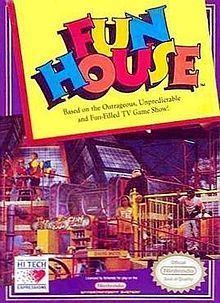Designer(s) Ironwind Software | Initial release date 1991 | |
 | ||
Similar Hi Tech Expressions games, Shooter games | ||
Fun House is a 1991 action video and personal computer game which is based on the U.S. version of the television show Fun House.
Contents
Released in 1991, it was marketed exclusively towards North American gamers. The systems that were intended to run this game were the NES and the PC's MS-DOS operating system (although it could work on Microsoft Windows with some effort). The DOS version was more faithful to the television program than the NES version (which simply was an action/shooter game with little connection to the TV series).
NES version
The general gameplay concept is that each level is like a child's version of The Running Man with a basic top-down view. Players must throw tomatoes skillfully at a series of easy-to-hit targets. Some elements of the game are indirectly taken from the classic arcade game Pole Position (except that the player does not have the option to play as a Formula One vehicle).
In order to make it to the next level, the player must make it from the starting line to the finish within the time limit with a young child on inline skates. Otherwise, the player loses a chance and the player must start the stage over again. The host of the televised game show, J. D. Roth, congratulates players for winning a stage while taunting the player with late 1980s/early 1990s sarcasm when he loses a "chance." Icy floors and slime colored ramps offer an additional challenge to the player. There are 72 rooms in the entire Fun House; with targets that are either numbered or given a generic target graphic. Each room has a name that usually gives a clue about how the room's design is implemented; either as clues that describe themselves or as a pun-laden name.
Although the player is given three chances to successfully navigate the entire Fun House, collecting 25 silver coins acts as a 1-up. Warp zones will allow players to access the more difficult levels of the Fun House at an earlier time; thus allowing gamers who are pressed for time a chance to beat the game with a higher level of risk.
MS-DOS version
In the MS-DOS version of Fun House, the players have to play in three mini-games before a trivia round; they are either a shooting game or a different kind of arcade game. After answering three kid-oriented trivia questions (usually about ice cream or elementary school knowledge), they had to run through the Fun House Maze for some more points. Each player had to go into the Fun House three times to pick up prizes. Most of the prizes were good (adds points to the score) while some of them were actually obstacles (deducts points from the score).
